Introduction: In this article, Mary Harrell-Sesniak searches old newspapers and records from the U.S. Patent Office to learn about the patents for women’s underwear – especially by women inventors. Mary is a genealogist, author and editor with a strong technology background.
Admit it, you’re curious – just what kind of underwear did women wear in the past?
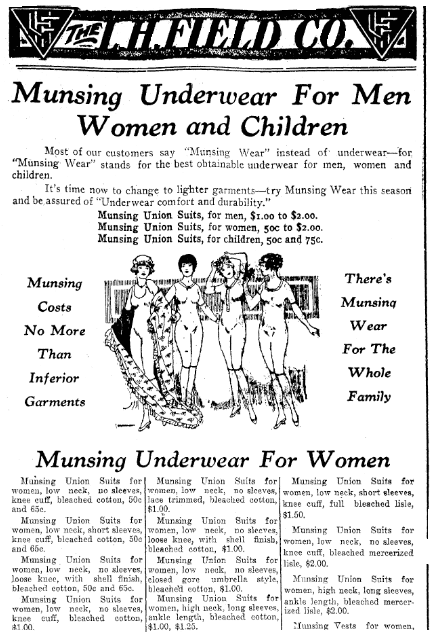
To find out about historical underwear, I searched old newspapers and patents and found some interesting examples. Men designed undergarments – but not surprisingly, women did too. Most of their designs served specific purposes. It’s not clear which of these became household items, but even if they didn’t, they were of use to women somewhere.
Note: if you’re squeamish about looking at what goes under a woman’s outfit, close this blog page now. Some of the designs address garments for menstruating women and nursing mothers – and others are not exactly what you would call attractive or sexy.
An Improvement in Underclothing for Women (1875)
I would suggest that Susan T. Converse’s design could be described as cuter than most, and if the accompanying description on Google Patents is correct, an improvement over other designs.

In 1875, she received United States Patent #166,190 – and much to my delight, it contained useful genealogical data you’re likely to spot in other patent records.
No, we do not learn the names of family members, although one could assume her witnesses, Julia Moulton and J. P. Convers, were either associates, friends or family. If you find her in your family tree, I suggest you track them down to see how they are connected.
In addition to the witnesses, we also find this information in her patent record:
- What her middle initial stands for: Taylor
- Her residence as of her application date: Woburn, Massachusetts
- Her signature, which can be compared to other applications and old documents (this helps if you are confused if someone with the identical name is the same person)
I’ll let you search these details, but if you cross reference the name with her memorial on Findagrave you’ll learn someone identified her as a Mayflower descendant. That’s cool, as she is probably one of my distant cousins.
Note: I notice in the description she wrote for her “Improvement in Under-Clothing for Women” patent application a certain high level of literacy.

Genealogy Tip: Remember to search for female names by initials. We often falsely assume this is only important for men, but as you can observe at the bottom of Susan’s patent application, she is identified as S. T. Converse.
Milk-Catcher for Nursing Women (1884)
It takes a woman, such as Lydia Emeline Pattee of Smith Centre, Kansas, to understand the needs of lactating women. In 1884 she created a milk-catcher. No model was submitted, but she did attach a detailed drawing and described one of her preferences for materials:
“I prefer to make the protectors of white rubber or gutta-percha, the same material of which are made the bulbs of breast-pumps and the nipples of nursery bottles. As this is flexible, it will not bruise the breast…”
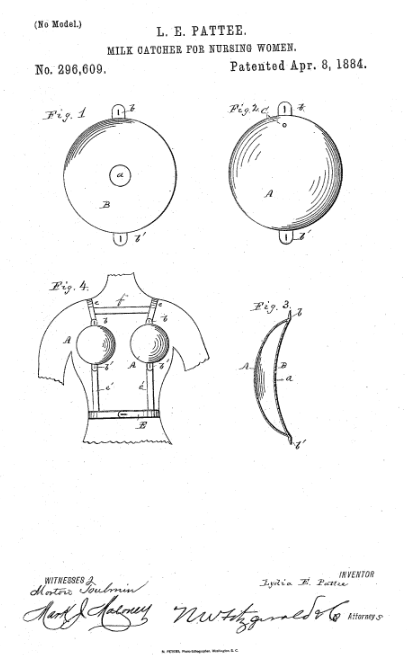
What is gutta percha you may wonder? A Web definition indicates it comes from the coagulated latex of certain Malaysian trees, now used mostly in dentistry and electrical insulation.
Belt for Women’s Undergarments (1892)
Martha C. Geldowsky of St. Louis, Missouri, addressed the problem of how to hold up and put on undergarments. This might have been a problem with old-time garments and their lack of elasticity. Her belt, as you can see from the drawing, allowed a woman to suspend various unidentified items from the device. Interesting how her comment discussed how women typically dressed.
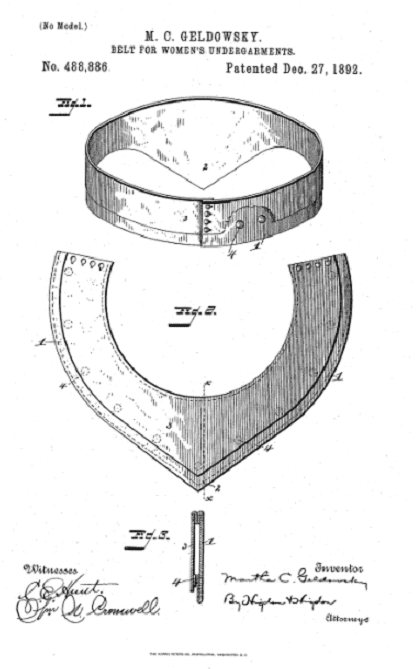
It will also be obvious that there is no unnecessary loss of time in dressing, and the old-fashioned way of throwing some of the undergarments over the head is entirely dispensed with.
Corset Reinforcer (1898)
One of the devices of the past that has happily gone by the wayside, is the corset.
Judging from the numerous patents (both for men and women), corset design went through many variations. One was made by Rebecca M. Oursler of Allegheny, Pennsylvania, who received patent #600551 in 1898 for a corset reinforcer. One of its benefits was described as:
“The device is cheap, neat, and inexpensive and may be applied to any style of corset. It is also readily removed if for any reason it should be necessary to do so.”

So, who was Rebecca? Her burial is at Allegheny Cemetery in Pittsburg, and her Findagrave memorial identifies her middle initial as Morton. I found several newspaper articles that follow the family for two generations, including the Oursler-Secrest wedding of 1901.
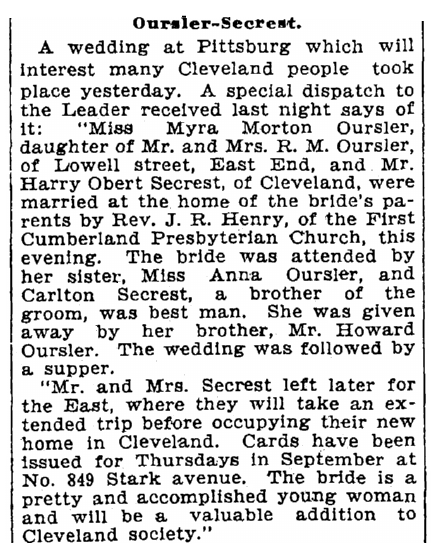
In 1930, another newspaper article described the wedding of Miss Florence Secrest, daughter of Mr. and Mrs. Harry O. Secrest, to Harold K. Baumgardner.
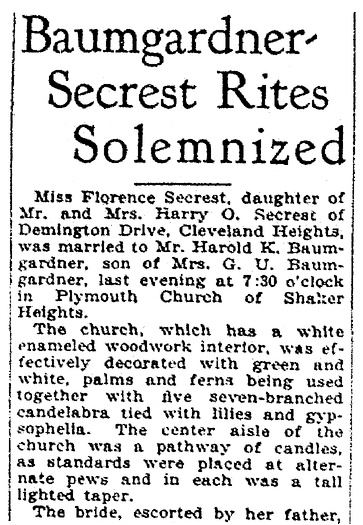
Notice that she wore an antique scarf with the orange blossoms from her maternal grandmother’s wedding. Given the family connection to corsets, I’m thinking the scarf was a better choice to complete the “something old or borrowed” tradition.
Appliance for Women’s Wear (1900)
In 1900, Chestora C. and husband John Henry Carr received a patent for an appliance for women’s wear. They apparently worked together to devise a useful contraption.
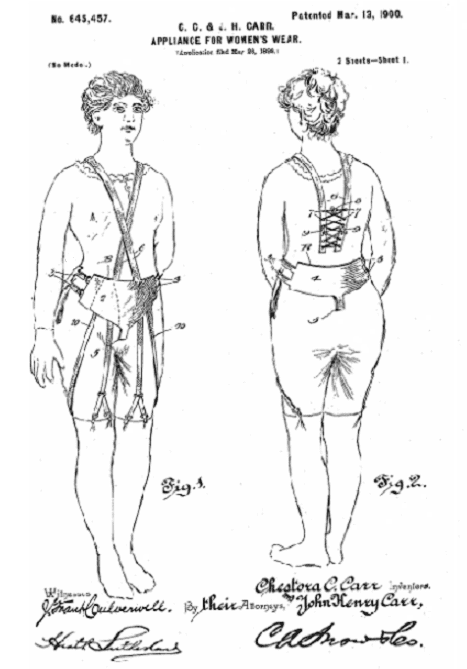
The description reads:
“Broadly the device includes a member adapted to be worn on the body, in combination with a garment, of a hook and eye, the respective parts of which are secured to said member…”
I found only one newspaper from Michigan that made notice of their invention, among a list of patents granted in Michigan. It’s possible she was the only female inventor from her home state in 1900.
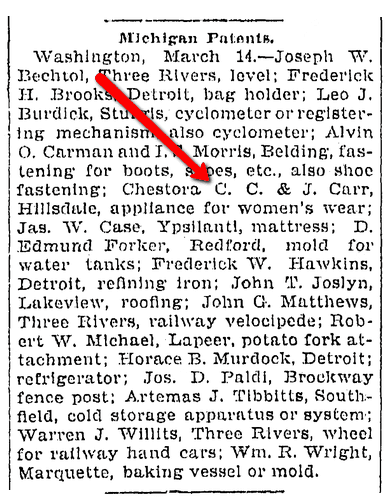
If you have Carr ancestry, you might look to see how she is related to you. Some clues as to relations are found in her and her husband’s Findagrave memorials.
Genealogy Tip: Women’s inventions were sometimes not mentioned in their obituaries – so if you don’t know if your ancestor was an inventress, start searching patent databases. You might discover there was a female inventor in your lineage.
Catamenial Garment (1906)
“Catamenial” refers to a woman’s monthly cycle, so it’s of no surprise that a woman, Sarah G. Schiff, addressed the issue with a special garment. Her patent application noted several novelty features and included a description of how to use the garment. In addition to openings, the interior fabric was waterproof.
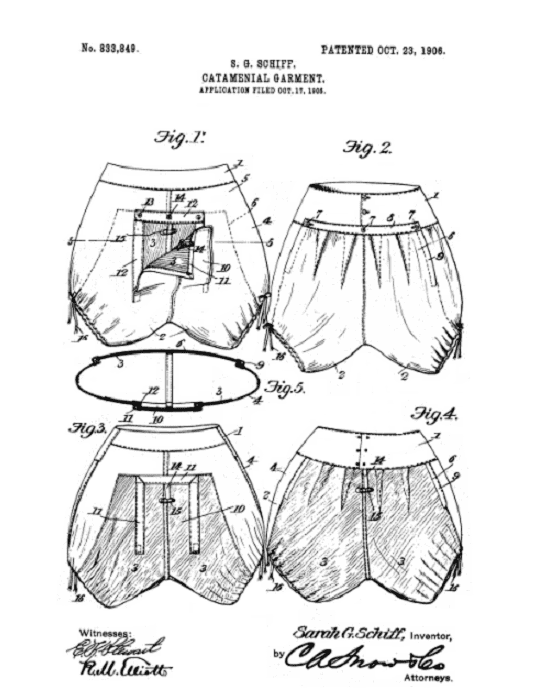
Searching for Inventors & Inventions
To search for patents of your ancestors or other women – or to learn more about the innovations I featured in this article – head to these websites for more information:
Note: An online collection of newspapers, such as GenealogyBank’s Historical Newspaper Archives, is not only a great way to learn about the lives of your ancestors – the old newspaper articles also help you understand American history and the times your ancestors lived in, and the news they talked about and read in their local papers – as well as the clothes, and underwear, they wore.
Please let me know if you locate a female ancestor’s patented invention by leaving a note in the comments section below.
Related Articles:

A very interesting article! And I was particularly interested because among my great-great-grandmother’s hand-me-downs, I inherited a pair of those bloomers that consist of two legs not joined together. A rather strange heirloom.
Vera Marie,
Thanks for sharing this account of your delightful family heirloom. Hope it survives for future generations to enjoy!
Mary